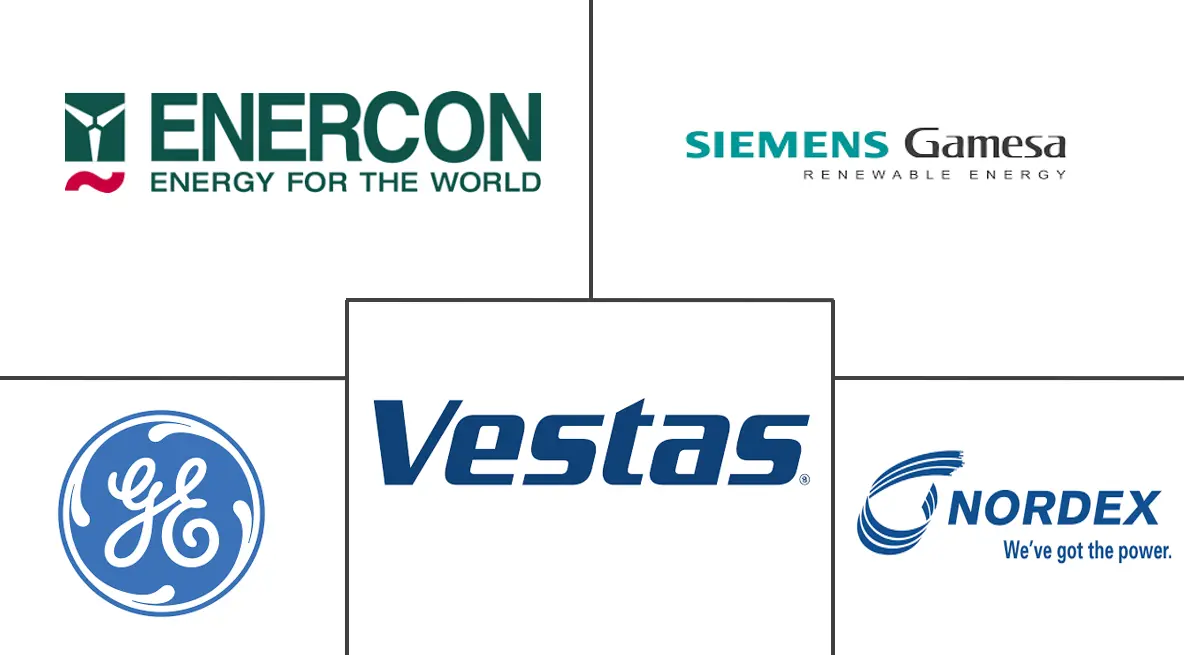Market Size of Germany Wind Energy Industry

| Study Period | 2019 - 2029 |
| Base Year For Estimation | 2023 |
| Forecast Data Period | 2024 - 2029 |
| Historical Data Period | 2019 - 2022 |
| CAGR | > 3.00 % |
| Market Concentration | Medium |
Major Players
*Disclaimer: Major Players sorted in no particular order |
Germany Wind Energy Market Analysis
During the forecast period, the German wind energy market is expected to register a CAGR of more than 3% per year.
- Over the next five to ten years, the wind energy market in the country is likely to be driven by things like new wind energy projects, more investments, helpful government policies, and financial incentives.
- But the growing use of clean energy sources like solar and the availability of fossil fuels are likely to slow the growth of Germany's wind energy market over the next few years.
- Still, wind energy made up a big part of energy production and met one-fourth of the world's electricity needs in 2021. There are ambitious plans for the expansion of wind energy to 40 GW by 2035 and 70 GW by 2045. This is expected to create immense opportunities for the German wind energy market.
Germany Wind Energy Industry Segmentation
Wind power is made by the force of the wind, mostly through the rotor, which turns kinetic energy into mechanical energy, and the generator, which turns this mechanical energy into electrical energy.
The German wind energy market is segmented by location of deployment. By location of deployment, the market is segmented into onshore and offshore. For each segment, the market sizing and forecasts have been done based on installed capacity (GW).
Germany Wind Energy Market Size Summary
The wind energy market in Germany is poised for growth, driven by new projects, increased investments, and supportive government policies. Despite challenges from the rising adoption of solar energy and the availability of fossil fuels, wind energy remains a significant contributor to the country's electricity production. Germany has ambitious plans to expand its wind energy capacity, particularly offshore, where higher wind speeds offer lucrative opportunities. The government's commitment to enhancing offshore wind development in the North and Baltic Seas is expected to significantly boost the sector, aligning with the country's renewable energy targets.
Germany's wind energy market is characterized by a moderate level of fragmentation, with key players such as Nordex SE, Enercon GmbH, and Siemens Gamesa Renewable Energy SA actively contributing to the sector's growth. The government's strategic initiatives, including the WindLandG law, aim to accelerate the development of onshore wind power plants, further supporting the market's expansion. As the demand for clean, reliable, and cost-effective energy sources increases, wind power is becoming an increasingly viable solution, offering substantial economic and environmental benefits. The ongoing investments and policy support are anticipated to drive the wind energy market forward in the coming years.
Germany Wind Energy Market Size - Table of Contents
-
1. MARKET OVERVIEW
-
1.1 Introduction
-
1.2 Wind Energy Installed Capacity and Forecast in GW, till 2028
-
1.3 Recent Trends and Developments
-
1.4 Government Policies and Regulations
-
1.5 Market Dynamics
-
1.5.1 Drivers
-
1.5.2 Restraints
-
-
1.6 Supply Chain Analysis
-
1.7 PESTLE Analysis
-
-
2. MARKET SEGMENTATION - BY LOCATION OF DEPLOYMENT
-
2.1 Onshore
-
2.2 Offshore
-
Germany Wind Energy Market Size FAQs
What is the current Germany Wind Energy Market size?
The Germany Wind Energy Market is projected to register a CAGR of greater than 3% during the forecast period (2024-2029)
Who are the key players in Germany Wind Energy Market?
General Electric Company, Enercon GmbH, Nordex SE, Siemens Gamesa Renewable Energy, S.A. and Vestas Wind Systems A/S are the major companies operating in the Germany Wind Energy Market.

